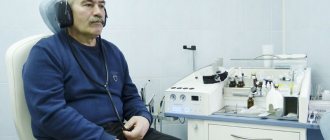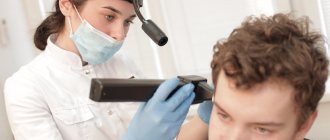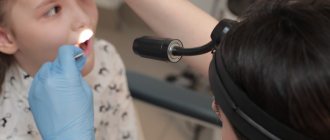Labyrinthitis is a disease of the internal organs of hearing, which has many symptoms and can occur in different ways.
Author:
- Oganesyan Tigran Sergeevich
ENT pathology expert
(Voted by: )
Labyrinthitis is a disease of the internal organs of hearing, which has many symptoms and can occur in different ways. Labyrinthitis affects both adults and children equally. It is important to diagnose it in a timely manner and provide adequate therapy. If left untreated, severe complications may develop, including complete and irreversible hearing loss. As labyrinthitis develops, changes occur in its functional mechanism, and there is a failure in the transmission of sensory information on the way from the ear to the brain. Otitis develops not only as a result of infection from the nasopharynx, but also mechanical damage (careless cleaning of the ear with a cotton swab) can be the cause of development. Also, otitis of the inner ear can develop as a result of the progression of common diseases (measles, mumps). Pathogenic microorganisms enter the ear through the blood and cause inflammation there.
Symptoms of labyrinthitis
With labyrinthitis (otitis of the inner ear), there is a complex disorder of the vestibular apparatus, loss of orientation in space, dizziness, and tinnitus. If the disease progresses significantly, it is difficult for a person to take a vertical position (stand up, sit down), and there are significant restrictions in the control of his movements.
Symptoms of the disease:
- sweating;
- nausea and vomiting;
- loss of coordination;
- noise in ears;
- dizziness;
- tachycardia;
- pale skin.
Also, labyrinthitis is often accompanied by Vertigo syndrome (sensation of rotation), high body temperature (up to 38 degrees), fainting, slurred speech, vomiting, partial or complete hearing loss, and tinnitus.
Diagnosis of labyrinthitis
Diagnosis of labyrinthitis begins with a careful collection of anamnesis, patient complaints, and clarification of the characteristics of the clinical picture of the disease. If the etiology of labyrinthitis is unclear, or to obtain additional information, the following studies may be performed:
- audiometry - this instrumental diagnostic method is aimed at subjectively determining the level of hearing acuity in a patient with labyrinthitis. Diagnostics are carried out using the latest generation devices, which make it possible to register the slightest hearing problems;
- electronystagmography – allows you to use the electrodes of the device to record the movements of the eyeballs;
- computed tomography and magnetic resonance imaging - these highly informative diagnostic methods are necessary to identify pathological processes in the patient’s brain (tumors, stroke areas);
- Auditory Brainstem Response Test, or ABR, evaluates the passage of nerve impulses along the auditory nerve from the inner ear to the functional part of the brain. This can help identify damage to the auditory nerve.
When to see a doctor?
You should make an appointment with your doctor if you have:
- Vertigo syndrome;
- fainting;
- slurred speech.
Contact your doctor immediately if you have:
- increased body temperature 38 C;
- convulsions;
- visual double vision;
- severe vomiting;
- paralysis.
It is important to consult a doctor in a timely manner to prescribe therapy. With timely treatment, the disease subsides within a week. In the case of a complicated course of the disease, its manifestations increase and have a pronounced character over 15–20 days. In advanced situations, the auditory nerve receptors are completely destroyed and hearing cannot be restored.
Treatment of labyrinthitis
Since the disease causes a wide range of symptoms, most of which are painful for the individual; affects an important organ; causes many complications, it is not surprising that its treatment is a comprehensive, systemic and complex process, which includes not only taking medications, but also regular examinations and procedures. Surgery is also possible. During the recovery period after an illness, hearing prosthetics is sometimes indicated.
Medicines prescribed for labyrinthitis are anti-inflammatory drugs, antibiotics, drugs to increase blood circulation, and neuroprotectors. Symptoms of the disease are relieved by ballataminal and betahistine, vestibulolytics.
Surgical intervention can be aimed at sanitation of the middle ear, plastic surgery of the labyrinth fistula, opening of the temporal skin pyramid, or even complete removal of the labyrinth with drainage of the cranial cavity.
Recovery after surgery may involve the need to install a hearing prosthesis to maintain the patient's current state of health and prevent deterioration in the ability to perceive sounds. To do this, either cochlear implantation is performed - an invasive manipulation that restores hearing. Or prosthetics are shown, and the selection and adjustment of the device is carried out by a hearing care specialist.
Causes
Otitis of the inner ear causes the spread of an infection of viral or bacterial origin. Often the cause is a previous upper respiratory tract infection (influenza, acute respiratory infections, ARVI).
Causes causing the disease:
- streptococcal infection;
- meningococcal infection;
- pneumococcal infection;
- influenza virus.
Another cause of the disease is ear injury. Injuries can be mechanical, chemical or thermal.
2. Reasons
Almost always labyrinthitis is secondary, i.e. is a consequence and complication of another pathology (usually in adjacent structures). Primary labyrinthitis is very rare, caused, for example, by the presence of congenital cystic-necrotic formations. More often, primary labyrinthitis of traumatic origin is recorded, developing as a result of gunshot, industrial, household or iatrogenic injuries, especially if they are accompanied by perforation of the eardrum.
However, in the vast majority of cases, inflammation of the inner ear is complicated by inflammation of the middle ear (otitis media); Another common variant of etiopathogenesis is the descending expansion of the infectious agent from the inflamed meninges during meningitis. The range of possible pathogens is very wide, it includes both representatives of the kingdom of viruses (measles, influenza, herpes, rubella, etc.) and bacterial pathogens of purulent otitis, acute or chronic (staphylococcus aureus or hemolytic staphylococci predominate). Viral secondary labyrinthitis is much more common than bacterial labyrinthitis.
Visit our Therapy page
Risk factors
Factors that increase the risk of developing labyrinthitis:
- decreased immunity;
- anatomical features of the structure of the ear cavity;
- frequent inflammatory processes in the middle ear.
There are 2 types of labyrinthitis - purulent and non-purulent. The first is a dangerous condition with serious consequences, the second is much easier.
And finally, like many other diseases, inflammatory processes in labyrinthitis can be acute or chronic.
Classification of labyrinthitis
There are several ways to classify this disease. Labyrinthitis can be classified according to the type of inflammation, the prevalence of the inflammatory process, the nature of the disease, the mechanism of occurrence and the nature of the infectious agent.
- According to the mechanism of occurrence, it is divided into: Timpathogenic - the infection penetrates into the labyrinth from the middle ear.
- Meningogenic - from the membranes of the brain, most often when the patient has meningitis.
- Hematogenous - the infection enters the labyrinth through the bloodstream.
- Traumatic - labyrinthitis occurs as a complication after a cranial or ear injury.
- Viral.
- specific;
- nonspecific.
- According to the nature of inflammation, labyrinthitis is divided into:
- Serous - pronounced changes in the labyrinths; increased production of endolymph; the appearance of blood cells and fibrin in the endolymph.
- Purulent - spontaneous inflammation; constant formation of granulations; the occurrence of leukocyte infiltration.
- Necrotic - tissue necrosis; disruption of the blood supply to areas of the labyrinth; thrombosis or compression of the artery; artery damage, vascular dysfunction due to edema.
- According to the prevalence of the inflammatory focus, labyrinthitis is divided into:
- Diffuse;
- Limited.
- According to the nature of the disease, labyrinthitis is divided into:
- Acute - inflammation goes away after 2-3 weeks, can be protracted or become chronic;
- Chronic - asymptomatic, gradual increase in symptoms.
Complications
Prolonged inflammation of the hearing organs entails many negative and unpleasant complications, often leading to incurable consequences:
- neuritis of the facial nerve - its inflammation;
- mastoiditis – infectious inflammation of the mastoid process of the temporal bone;
- petrositis is a purulent inflammation of the temporal bone.
The consequences of limited type labyrinthitis may be the development of a diffuse purulent process in the inner ear, as well as the need for a long course of treatment.
The result of the purulent variant of the described disease may be loss of function of the inner ear, that is, the development of intracranial complications. Complications of serous labyrinthitis are reduced to permanent dysfunction of the auditory analyzer and vestibular apparatus. And also before the development of a purulent labyrinth with the functional death of all receptors in the inner ear.
4.Treatment
Labyrinthitis, especially acute, is a direct indication for hospitalization and treatment in a hospital setting. Acute purulent variants require urgent surgical intervention; if it is indicated for chronic labyrinthitis, they strive to implement it during the period of remission. In the most severe cases, the labyrinth must be removed completely (labyrinthectomy). Drug treatment, adjuvant and maintenance therapy usually include palliatives for the relief of vestibular disorders (vestibulolytics), antiemetics, neuroprotectors, hormonal anti-inflammatory drugs and sedatives.
Treatment
There are two methods of treating labyrinthitis:
- Conservative, that is, the prescription of broad-spectrum antibiotics, vitamins, magnesium, diuretics to eliminate intoxication.
- Surgical treatment (labyrinthectomy) is used in the case of purulent form of labyrinthitis.
First, conservative treatment is carried out, then surgery. The intervention is carried out to cleanse the affected area of the labyrinth from pus. In cases of severe damage to the labyrinth, its complete removal is possible.
Causes and pathogenesis of labyrinthitis
An inflammatory infection attacking the labyrinth can be caused by several reasons. In each case, internal otitis is caused by the movement of bacteria from the source of inflammation, but the reason why this happens may be different.
The source of inflammation that causes labyrinthitis can be otitis media, which destroys the connective tissue membranes of the ear, and this allows the infection to penetrate the labyrinth, causing suppuration and hearing impairment.
It is also quite likely that infection can penetrate through the cranial cavity, for example due to meningitis or influenza. The cause of such inflammation can be measles, tuberculosis, typhoid, syphilis, herpes, scarlet fever. Here, infection can also penetrate through the blood.
An ear injury, due to which the patient's eardrum was damaged, also causes purulent inflammation and labyrinthitis. This also includes those cases where the injury to the eardrum occurred due to the penetration of a foreign body, manipulation of a sharp object, or traumatic brain injury.
Causes and course of the disease
The main causes of labyrinthitis are:
- the appearance in the inner ear of streptococcus, staphylococcus or tuberculosis bacteria, which can be carried by the bloodstream (hematogenous route of infection);
- location of foci of meningitis near the inner ear, for example, in the skull area;
- it is possible to develop syphilis of the labyrinth, which can also get into the inner ear, through the bloodstream and any other routes of penetration.
— it is possible for an infectious agent to penetrate into the area of the inner ear from the membranes of the brain. Typically, this occurs through the internal auditory canal and the cochlear aqueduct.
The etiology of labyrinthitis is polymorphic and is caused by the influence of various viruses, bacteria, toxins and injuries. But streptococci, staphylococci and mycobacterium tuberculosis still play a significant role in the development of this disease. The causative agent of meningococcal labyrinthitis can be: meningococcus, pneumococcus, Mycobacterium tuberculosis, tryponema pallidum, influenza and mumps viruses A and B.
Morphological changes in the inner ear are always different and usually correspond to the clinical picture of one or another type of labyrinthitis.
With serous labyrinthitis, endolymphatic edema, swelling, as well as vacuolization and disintegration of the neuroepithelium are observed.
With purulent labyrinthitis, initially there is an accumulation of polymorphonuclear leukocytes and bacteria in the perilymphatic space against the background of dilated vessels, but then these changes pass into the endolymphatic space, edema begins to progress and necrosis of the membranous, and subsequently the bone walls of the labyrinthine tissue occurs, which leads to destruction of all receptor and nerve elements.
Necrotizing labyrinthitis is characterized by areas of necrosis of soft tissues and the capsule of the labyrinth with areas of the inflammatory process, which may be limited to either one part of the labyrinth or will take over it entirely.
The morphological picture of specific labyrinthitis has its own characteristics, namely:
- in tuberculosis it manifests itself in two forms - proliferative and exudative;
- in syphilis, it manifests itself as meningoneurolabyrinthitis, manifesting as osteitis of the temporal bone involving membranous labyrinthitis.
With labyrinthitis, degeneration of the epithelial cells of the inner ear and swelling of the walls of the labyrinth are observed. Since the disease can be purulent, it is characterized by the accumulation of pathogenic bacteria and leukocytes, which, if untreated, cause severe swelling of the walls of the labyrinth, and then necrosis of its tissues and bone cells.
Labyrinthitis can also have a necrotic course of the disease, when soft tissue atrophy is observed, which is focal in nature. In this case, the otorhinolaryngologist needs to identify and establish an inflammatory process in the ear, which can have either minor inflammation or widespread inflammation.
Make an appointment right now!
Call us by phone or use the feedback form
Sign up
Taking into account the stated etiological factors, pathogenesis, characteristics of clinical manifestations, the extent of the inflammatory process and pathomorphological characteristics, a scheme has been adopted for clinical use dividing labyrinthitis into several types.
Types of labyrinthitis
. The scheme by which labyrinthitis is distinguished was proposed by Professor I.B. Soldatov, who devoted his entire life to the study of diseases of the ear, nose and throat and made a great contribution to solving the problem of labyrinthitis.
1. Labyrinthitis can be divided according to the etiological factor into:
- tuberculosis and syphilitic;
- specific and nonspecific;
2. Labyrinthitis can be classified according to pathogenesis. This:
- meningogenic;
- hematogenous;
- tympanogenic;
- otogenic.
3. Types of labyrinthitis according to the course and severity of manifestations:
- acute and chronic;
- explicit and latent.
4. Types of labyrinthitis according to the prevalence of the inflammatory process:
- diffuse (when the distribution covers all parts of the inner ear);
- limited (when only one specific area is affected).
5. Labyrinthitis can be divided according to pathomorphological characteristics. This:
- serous;
- purulent;
- necrotic.
Clinical picture
The severity of clinical symptoms depends on the rate of spread of infection in the inner ear. Signs of the disorder:
- systemic dizziness (a feeling of rotation of surrounding objects and one’s body lasting from several minutes to several hours, which can be paroxysmal);
- hearing loss up to complete deafness;
- noise in the affected ear (usually high-frequency, with a tendency to increase when turning the head);
- autonomic reactions (nausea, vomiting, increased sweating);
- imbalance.
When inflammation spreads to the trunk of the nerve running between the vestibule and the cochlea, peripheral paresis of the facial nerve is observed.
The course of the acute form of the disease is about 2-3 weeks, then recovery occurs. In other cases, the pathology becomes chronic and can drag on for several years, making the patient unable to work. The spread of infection into the skull area leads to intracranial complications.
How to cure labyrinthitis
After diagnosis, treatment begins. Depending on the type of disease and the general condition of the patient, otolaryngologists offer to undergo:
- drug therapy. Antibacterial drugs fight the pathogens of the disease, dehydration agents quickly eliminate intoxication of the body;
- surgical intervention. If the condition is neglected, pharmacological agents are ineffective, or there is a fistula or fistula in the hearing aid, surgeons are involved in treatment. General cavity surgery will help remove purulent exudate and restore hearing. If necessary, plastic surgery of the auditory bone or prosthetics is performed.
FEATURES OF THE DIAGNOSTIC PROCESS
The key task of the diagnostician comes down to:
- the difference between labyrinthitis and neurinoma/otosclerosis/neuritis/ataxia/cerebellar dysfunction requiring treatment;
- determination of the form (hematogenous/tympogenic/traumatic/meningogenic, serous/purulent/neurotic, viral/bacterial/fungal labyrinthitis) in order to prescribe treatment in a timely manner in accordance with the level of risk.
For these purposes, a long series of studies are carried out at 3 levels. The first stage is the study of auditory function (mandatory during treatment of labyrinthitis): tests with a tuning fork, impedance testing, electrocochleography, audiometry (including threshold testing), promontorial testing. Here is (micro)otoscopy.
Testing of vestibular function in cases of suspected labyrinthitis is carried out through videoculography, electronystagmography, vestibulometry, stabilography, fistula and caloric tests. To exclude damage to adjacent brain tissues during delayed treatment, CT scan of the skull, X-ray of the head, and MRI are recommended. In rare cases (in the absence of treatment/with a significant threat) - a spinal puncture.
To determine the causative agent of labyrinthitis, RPR testing (suspicion of syphilis), RIF/ELISA and PCR diagnostics are prescribed. Standard smears and blood/urine tests are also required for labyrinthitis.











